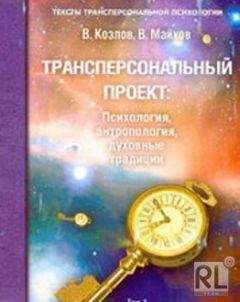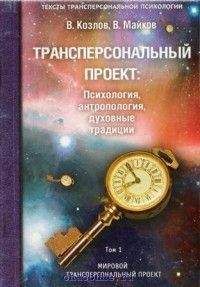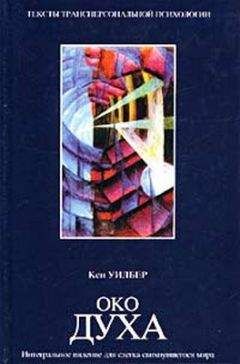Кен Уилбер - Проект Атман
[77]. Chile, С Man makes himself. New York: Mentor, 1957.
[78]. Chomsky, N. Syntactic structures. The Hague: Mouton, 1957.
[79]. Chomsky, N. Language and mind. New York: Harcourt, 1972.
[80]. Conze, E. Buddhist meditation. New York: Harper, 1956.
[81]. Conze, E. Buddhist wisdombooks. London: Allen and Unwin, 1970.
[82]. Cooley, C. H. Human nature and the social order. New York: Scribners, 1902.
[83]. Coomaraswamy, A. K. Hinduism andBuddhism. New York: Philosophical Library, 1943.
[84]. Coomaraswamy, A. K. Recollection, Indian and Platonic. Supplement to JAOS, no. 3, 1944.
[85]. Coomaraswamy, A. K. Time and eternity. Ascna: Artibus Asial, 1947.
[86]. Coomaraswamy, A. K. The dance of Shiva. New York: Noonday, 1957.
[87]. Cooper, D. Psychiatry and anti‑psychiatry. New York: Ballantine, 1971.
[88]. Corsini, R. Current personality theories. Itasca: Peacock, 1977.
[89]. Dasgupta, S. B. An introduction to tantricBuddhism. Berkeley: Shambhala, 1974.
[90]. Davidson, J. The physiology of meditation and mystical consciousness. PerspectiveBiology Medicine, Spring, 1976.
[91]. Dean, S. (ed.) Psychiatry and mysticism. Chicago: Nelson Hall, 1975.
[92]. Deikman, A. De‑automatization and the mystic experience. Psychiatry, vol. 29, 1966.
[93]. Desoille, R. The waking dream in psychoterapy. Paris: Presses Universitaires de France, 1945.
[94]. Deutsche, E. Advaita vedanta. Honolulu: East‑West Center, 1969.
[95]. Dewey, J. andBently, A. F. Knowing and the known. Boston: Beacon, 1949.
[96]. Dewey, J. and Tufts, J. Ethics. New York: Holt, Rinehart, Winston, 1908.
[97]. DiLeo, J. Child development, New York: Brunner/Mazel, 1977.
[98]. Duncan, H. Symbols in society. New York: Oxford Univ., 1968.
[99]. Edgerton, F. (trans). TheBhagavad Gita. New York: Harper, 1964.
[100]. Edinger, E. F. Ego and archetype. Baltimore: Penguin, 1972.
[101]. Ehrmann, J. (ed.) Structuralism. New York: Anchor, 1970.
[102]. Eisendrath, C. The unifying moment. Cambridge: Harvard, 1971.
[103]. Eliade, M. The myth of eternal return. New York: Pantheon, 1954.
[104]. Eliade, M. The sacred and the profane. New York: Harvest, 1959.
[105]. Eliade, M. Shamanism. New York: Pantheon, 1964.
[106]. Eliade, M. Images and symbols. New York: Sheed and Ward, 1969.
[107]. Eliot, C. Hinduism andBuddhism, vols. 1–3. New York: Barnes and Noble, 1968.
[108]. Erikson, E. Childhood and society. New York: Norton, 1963.
[109]. Erikson, E. Insight and responsibility. New York: Norton, 1964.
[110]. Evans‑Wentz, W. The Tibetanbook of the Dead. London: Oxford Univ., 1968.
[111]. Evans‑Wentz, W. The Tibetanbook of the great liberation. London: Oxford Univ., 1968.
[112]. Evans‑Wentz, W. Tibetan yoga and secret doctrines. London: Oxford Univ., 1971.
[113]. Fadiman, J., and Frager, I. (ed.) Personality and personal growth. New York: Harper, 1976.
[114]. Fadiman, J., and Kewman, D. (ed.) Exploring madness. Calif.:Brooks/Cole, 1973.
[115]. Fagan, J., and Sheperd, I. (ed.) Gestalt therapy. New York: Harper, 1970.
[116]. Fairbairn, W. Psychoanalytic studies of the personality. London: Tavistock, 1952.
[117]. Fairbairn, W.. An object‑relations theory of the personality. New York: BasicBooks, 1954.
[118]. Farber, L. The ways of the will. New York: BasicBooks, 1945.
[119]. Federn, P. Ego psychology and the psychoses. New York: BasicBooks, 1952.
[120]. Fenichel, O. The psychoanalytic theory of neurosis. New York: Norton, 1945.
[121]. Ferenczi, S. Stages in the development of the sense of reality. In Sex and psychoanalysis. Boston: Gorham, 1956.
[122]. Ferenczi, S. Thalassa. New York: The Psychoanalytic Quarteque, 1938.
[123]. Ferenczi, S. Furter contributions to the theory and technique of psychoanalysis. New York: BasicBooks, 1952.
[124]. Festinger, L. Theory of cognitive dissonance. New York: Peterson, 1957.
[125]. Feurstein, G. A. Introduction to theBhagavad Gita. London: Rider, 1974.
[126]. Feurstein, G. A. Texbook of yoga. London: Rider, 1975.
[127]. Fingarette, H. The self in transformation. New York: BasicBooks, 1963.
[128]. Flugel, J. Man, morals and society. New York: International Universities Press, 1945.
[129]. Foulkes, D. A grammar of dreams. New York: BasicBooks, 1978.
[130]. Frank, J. Nature and Function ofbelief systems: humanism and transcendental religion. American Psychologist, vol. 32, 1977.
[131]. Frankl, V. Man’’s sears for meaning. New York: Washington Square, 1963.
[132]. Freemantle, F., and Trungpa, С The Tibetanbook of the dead. Berkeley: Shamabhala, 1975.
[133]. Fremantle, A. The Protestant mystics. New York: Mentor, 1965.
[134]. Freud, A. The ego and the mechanisms of defense. New York: International Universities Press, 1946.
Freud, S. The standard edition of the complete psychological work of Sigmund Freud. 24 volumes, translated and editedby James Strachey. London: Hogarth Press and the Institute of Psychoanalysis, 1953–1964.
[135]. Freud, S. The interpretation of dreams. Standard Edition, vols. 4 and 5.
[136]. Freud, S. Three essays on the theory of sexuality. Standard Edition, vol. 7.
[137]. Freud, S. Totem and taboo. Standard Edition, vol. 13.
[138]. Freud, S. On narcissism: an introduction. Standard Edition, vol. 14.
[139]. Freud, S. Beyond the pleasure principle. Standard Edition, vol. 18.
[140]. Freud, S. The ego and the id. Standard Edition, vol. 19.
[141]. Freud, S. Civilization and its discontents. Standard Edition, vol. 20.
[142]. Freud, S. New introductory lectures. Standard Edition, vol. 22.
[143]. Freud, S. An outline of psychoanalysis. Standard Edition, vol. 23.
[144]. Freud, S. A general introduction to psychoanalysis. New York: PocketBooks, 1971.
[145]. Frey‑Rohn, L. From Freud to Jung. New York: Delta, 1974.
[146]. Fromm, E. Escape from freedom. New York: Farrar, Straus, and Giroux, 1941.
[147]. Fromm, E. Psychoanalysis and religion. New York: Bantam, 1967.
[148]. Fromm, E., Suzuki, D. Т., and De Martino, R. ZenBuddhism and psychoanalysis. New York: Harper, 1970.
[149]. Gardner, H. The quest for mind. New York: Vintage, 1972.
[150]. Gebser, J. Ursprung and gegenwart. Stuttgart: Deutsche Verlags‑Ansalt, 1966.
[151]. Gebser, J. Foundations of the aperspective world. Main Currents, vol.29, no. 2, 1972.
[152]. Geertz, C. The interpretation of cultures. New York: BasicBooks, 1973.
[153]. Gendlin, E. Experiencing and the creation of meaning. New York: Free Press, 1962.
[154]. Giovacchini, P. Psychoanalysis. In Corsini, R., reference note #88.
[155]. Glasser, W. Reality therapy. New York: Pocket, 1974.
[156]. Globus, G. et al. (eds). Consciousness and thebrain. Plenum, 1976.
[157]. Goble, F. The third force. New York: Pocket, 1974.
[158]. Goffman, E. The presentation of self in everyday life. Garden City: Anchor, 1959.
[159]. Goldstein, K. The organism. New York: AmericanBook, 1939.
[160]. Goleman, D. The varieties of the meditative experience. New York: Dutton, 1977.
[161]. Govinda, L. Foundations of Tibetan mysticism. New York: Weiser, 1973.
[162]. Gowan, J. Trance, art, and creativity. Northridge, С A; 1975.
[163]. Green, E., and Green, A. Beyondbiofeedback. New York: Delacourte, 1977.
[164]. Greenacre, P. Certain relationshipsbetween fetishism and faulty development of thebody image. Psychoanalytic Study of the Child, vol. 8, 1953.
[165]. Greenson, R. The technique and practice of psychoanalysis. New York: International Universities Press, 1976.
[166]. Grof, S. Realms of the human unconsious. New York: Viking, 1975.
[167]. Group for the Advancement of Psychiatry. Mysticism: spiritual quest psychic disorder? New York: Group for the Advancement of Psychiatry, 1976.
[168]. Guenon, R. Man and hisbecoming according to the Vedanta. London: Luzac, 1945.
[169]. Guenther, H. Buddhist philosophy in theory and practice. Baltimore: Penguin, 1971.
[170]. Guenther, H. Treasures on the Tibetan middle way. Berkeley: Shambhala, 1971.
[171]. Guenther, H. Philosophy and psychology in the abhidharma. Berkeley: Shambhala, 1974.
[172]. Guenther, H. trans. The life and teaching of Naropa. London: Oxford Univ., 1963.
[173]. Guenther, H., and Trungpa, C. The dawn of tantra. Berkeley: Shambhala, 1975.
[174]. Hakeda, Y. S., trans. The awakening of faith. New York: Columbia Univ., 1967.
[175]. Hall, С A primer of Jungian psychology. New York: Mentor, 1973.
[176]. Hall, R. The psycho‑philosophy of history. Main Currents, vol. 29, no. 2, 1972.
[177]. Harrington, A. The immortalist. New York: Random House, 1969.
[178]. Harris, T. I’’m o.k. — you" re o.k. New York: Avon, 1969.
[179]. Hartmann, H. Ego psychology and the problem of adaptation. New York: International Universities Press, 1958.
[180]. Hartshorne, C. The logic of perfection. Ulinoes: Open Cout, 1973.
[181]. Heard, G. The ascent of humanity. London: Jonathan Cape, 1929.
[182]. Heidegger, M. Existence andbeing. Chicago: Henry Regney, 1950.
[183]. Heidegger, M. Being and time. New York: Harper, 1962.
[184]. Heidegger, M. Discourse on thinking. New York: Harper.
[185]. Hixon, L. Coming home. Garden City: Anchor, 1978.
[186]. Hocart, A. Social origins. London: Watts, 1954.
[187]. Holdstock, Т., and Rogers, C. Person‑centered theory. In Corsini, R., reference note #88.
[188]. Hood, R. Conceptual Criticisms of regressive explanations of mysticisms. Rev. Religious Res., vol. 17, 1976.
[189]. Hook, S. (ed.) Dimensions of mind. New York: Collier, 1973.
[190]. Horney, K. The neurotic personality of our time. New York: Norton, 1968.
[191]. Hume, R., trans. The thirteen principle Upanishads. London: Oxford, 1974.
[192]. Husserl, E. Ideas. New York: Macmillan, 1931.
[193]. Huxley, A. The perennial philosophy. New York: Harper, 1970.
[194]. Jacobi, J. The psychology of С G. Jung. London: Routledge and Kegan Paul, 1968.
[195]. Jacobson, E. The self and the object world. New York: International Universities Press, 1964.
[196]. Jakobson, R. Child language aphasia and phonological universals. Quoted in Gardner, reference note #149.
[197]. James, W. The principles of psychology, vols. 1–2. New York: Dover, 1950.
[198]. James, W. Varieties of religious experience. New York: Collier, 1961.
[199]. Jantsch, E., and Waddington, C. (eds). Evolution and consciousness. Addison‑Wesley, 1976.
[200]. Jaynes, J. The origin of consciousness in thebreakdown of thebicameral mind. Boston: Houghton Mifflin, 1976.
[201]. John of the Cross, St. Dark night of the soul. Garden City: Doubleday, 1959.
[202]. John of the Cross, St. Ascent of Mount Carmel. Garden City: Doubleday, 1958.
[203]. Jonas, H. The gnostic religion. Boston: Beacon, 1963.
[204]. Jones, R. M. Contemporaty educational psycholgy: selected essays. New York: Harper, 1967.
Jung, C. G. The collected work of C. G. Jung, Adler, G., Fordham, M. and Read, H., eds.; Hull, R. F. C. trans. Bolligen Series XX, Princeton: Princeton Univ. Press.
[205]. Jung, C. G. Symbols of transformation, collected works 5.
[206]. Jung, C. G. Psychological types, collected works 6.
[207]. Jung, C. G. Two essays on analytical psychology, collected works 7.
[208]. Jung, C. G. The psychological foudations ofbelief in spirits, collected works 8.
[209]. Jung, C. G. The structure and dynamics of the psyche, collected works 8.
[210]. Jung, C. G. The archetypes and the collective unconscious, collected works 9.
[211]. Jung, C. G. Aion — researches into the phenomenology of the self, collected works 9, part 2.
[212]. Jung, C. G. Mysterium coniunctionis, collected works 14.
[213]. Jung, C. G. The portable Jung. Campbell, J., ed. New York: Viking, 1972.
[214]. Jung, C. G. Thebasic writings of С G. Jung. DeLaszlo, V. S., ed. New York: Modern Library, 1959.




